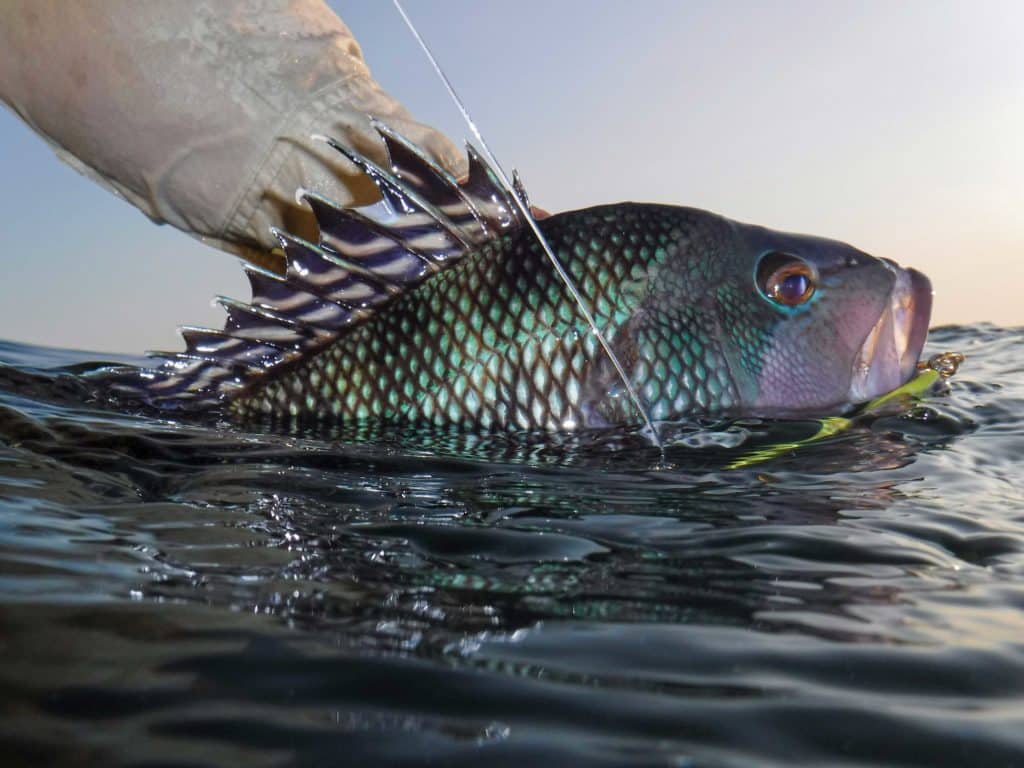
As my center-console drifted with the current in eastern Long Island Sound, I wiped the sweat from my forehead for the fifth or sixth time. It was August, but the hot fishing was every bit as responsible as the midsummer heat.
“We’re coming up on the hump,” I announced, free-spooling my 4-ounce diamond jig over the slope.
“Beat you to it!” Taylor exclaimed as he leaned back into the rod. “It’s heavy! I might need the net for this one.” But before I could reach for the landing net, I felt the whack of a predator hit my tumbling lure. I immediately took in line and set the hook, and my rod tip bent in a deep arc from the pull of a fish digging for the bottom.
Soon we added a pair of 20-inch black sea bass to the day’s catch, which now approached our two-person limit. The scene was surreal. We were gliding along a giant conveyor belt of blue-green seawater at midday. Neither birds, bait nor other vessels were in sight, but the fish finder was lit up over the rugged hump 70 feet below.
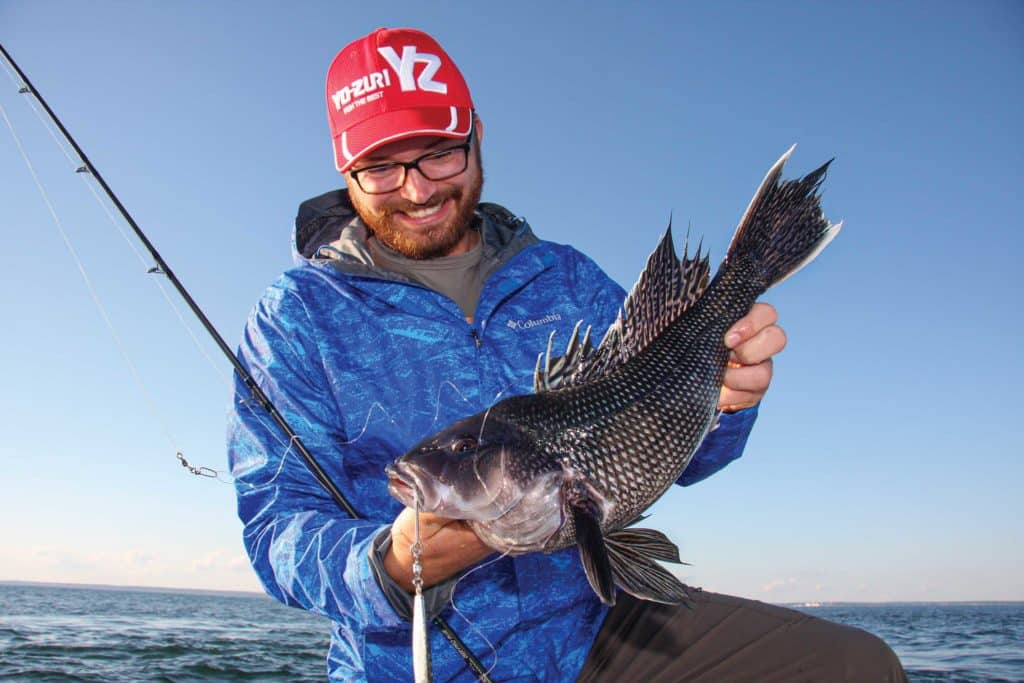
Population Explosion
While it’s getting harder to score big catches of winter flounder, fluke, cod and blackfish in Northeast waters, the robust stock of black sea bass has filled the void, even offering a great alternative for headboats targeting stripers and bluefish.
“The black sea bass population is exploding in southern New England,” says Michael Armstrong, Ph.D., assistant director of the Massachusetts Division of Marine Fisheries. “The biomass has translocated north due to climate change and warming waters, and you can hardly get your hook to the bottom in some spots. In northern Virginia, however, numbers are plummeting. The overall stock is in good shape, it has just moved north. This is a recent phenomenon, and sea bass, with their aggressive feeding habits, will undoubtedly change the ecosystem in ways scientists don’t yet understand,” especially from New Jersey to southern Massachusetts, where they’re now most dense.
“Anglers are even targeting them in Boston Harbor,” Armstrong says, “which was never the case. The Gulf of Maine is warming faster than 99 percent of the world’s oceans, and it’s bringing sea bass with it. In five to 10 years, they’ll be a regular occurrence even in Maine.”
Sea bass are opportunistic feeders, and their diet includes baby lobsters, crabs, sea worms, squid, and a wide range of baitfish. They congregate around specific rocky humps, and if you’re off the spot, you wouldn’t know there are sea bass in the area. So, targeting them successfully requires pinpointing their hangouts.
Any deep structure from Long Island Sound to southern Massachusetts likely holds sea bass. Knowledge of the best locations is coveted because a fleet can quickly pick a reef clean of fish. But southern New England features numerous productive spots, and many are seldom fished. For a shot at jumbos, it’s best to locate productive habitat on your own rather than joining a congregation of boats.
Although sea bass are occasionally active up through the water column, they’re true reef fish and relate to rock piles, reefs, ledges, wrecks and shoals from late May through September. They’re especially appreciated during the summer doldrums, when porgies are often the only other nearshore target available.
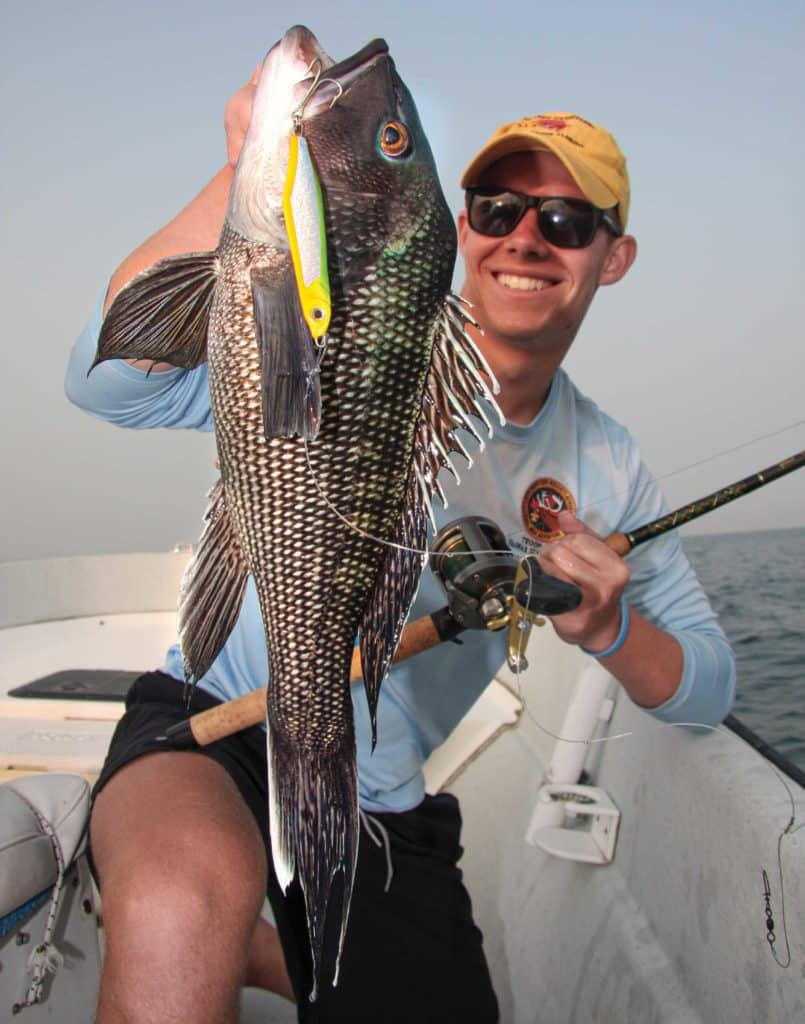
Locating Fish
“When targeting sea bass, the secret is finding a place that hasn’t been fished hard,” says Capt. Ned Kittredge, a pro from Westport, Massachusetts, with 45 years of experience.
“I look for deepwater rock piles in the 25- to 100-foot range, surrounded by a sandy bottom. I’ll also cruise along contours like steep gravel banks, looking for clusters on the fish finder. But you can use a paper chart if that is your preferred method.”
For late-season trophies, Kittredge recommends fishing outer rock piles, where he routinely wrestles up 5-pounders well into August. “Sea bass leave shallower hotspots such as Cleveland Ledge in Buzzards Bay in late June and stage on the deeper reefs from July to September.
“I’ve done well in 35 to about 70 feet in August. Prime sea bass areas are loaded with lobster and gill-net gear. I think that keeps the party boats away. So, any spots marked with lobster buoys are good areas to try,” he says.
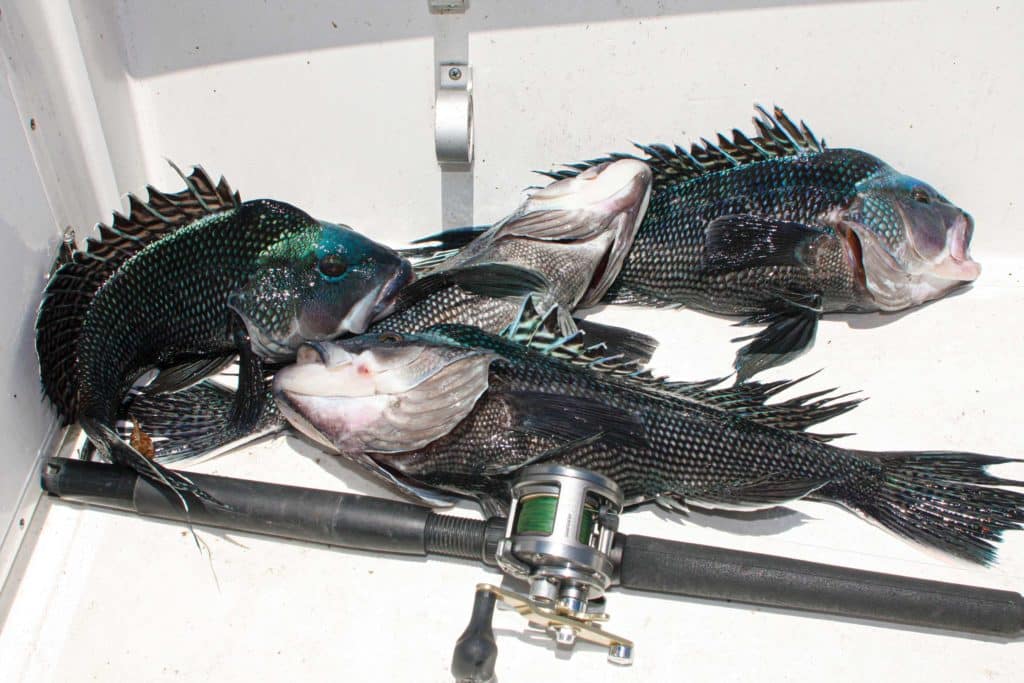
Fishing Rips
Rips form when a current sweeps over submerged structure, most of which holds sea bass all season. When you arrive at a promising spot during a moving tide, motor up-current of the rip line while watching your depth finder. At the point where the bottom levels off, stop the boat and let the current pull you back toward the structure.
Once you’re drifting, drop a 3- to 8-ounce diamond, Solvkroken or flutter jig (weight based on depth and current) and start working it, either slow-squidding eight turns up or maintaining an 18-inch snapping yo-yo motion as close to the bottom as possible. Continue this action until you reach the downslope of the reef and are into the rip line. In deeper areas with a strong current, fish about two hours on either side of a slack tide to reach bottom and maintain a vertical lure presentation.
Because sea bass are aggressive and occasionally follow prey to the surface, fishing methods vary. A common shallow-reef technique is to chum while anchored over structure. For deeper water or with swifter currents, however, the pros drift.
“I choose to drift,” Kittredge says, “because if a spot is unproductive or inundated with sand sharks, I’m not burdened with constantly setting and hauling the anchor to run to another place. I just run back up-current to retrieve snagged jigs and repeat productive drifts over a school or try different spots on a large reef. You’ll know right away if you’re on fish because the bites come fast and hard.”
Catching sea bass can be as simple as using a basic high-low rig and snelled 3/0 to 4/0 hooks baited with clams, squid or baitfish, and sinkers ranging from 4 to 8 ounces. You’ll have nonstop action with bait, but many fish will be small or short, and you’ll often be pestered by porgies.
Read Next: New England Sabiki-Style Sea Bass
To cull out the small fish and target trophies, an advanced technique is to replace the bait rig with a diamond or flutter-style metal jig, which sea bass eagerly strike. A variation is to tie in a dropper 8 to 10 inches above the jig and rig a 3/0 hook from it threaded with a soft-plastic or bucktail teaser sweetened with a squid strip. Fish this rig with either the jigging or squidding motion. Always be sure your line slacks on the drop to achieve a fluttering action on any jig.
“One of the best things about black sea bass,” Armstrong says, “is they bite all day. To be successful with striped bass, you need to be on the water at sunrise or sunset. But I like a species where I can stand in the boat at noon, drop a line down, and have great action.”
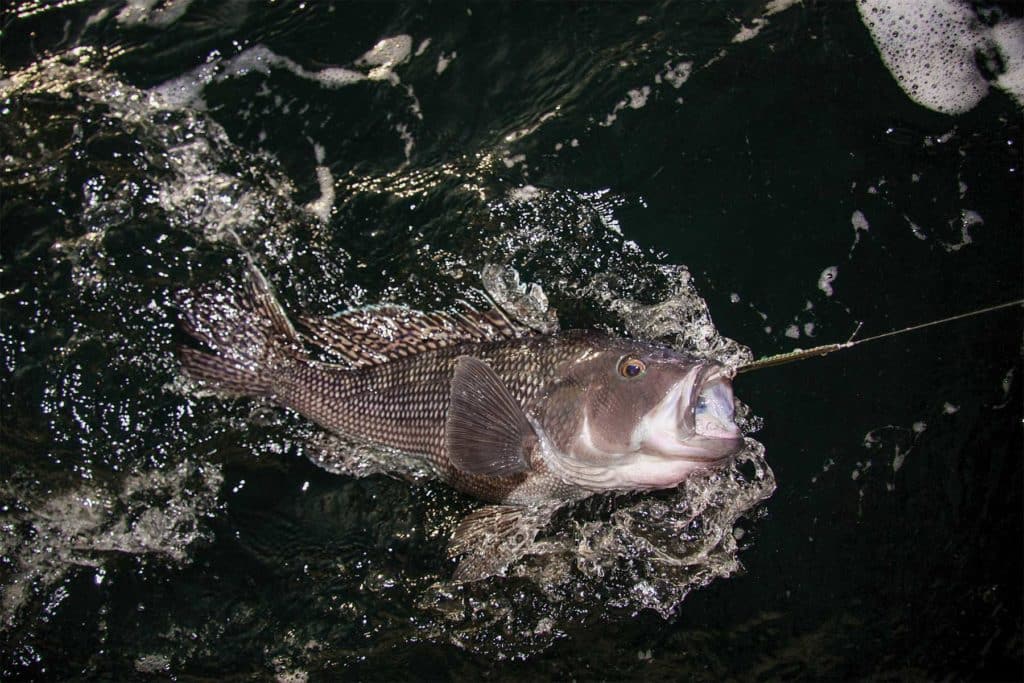
Which Sea Bass Are You Eating?
The true black sea bass is a type of grouper (Serranidae family) that ranges from Maine to Florida and the eastern Gulf of Mexico. Although they can inhabit offshore depths of 400 feet or more, anglers generally target them in waters between 25 and 130 feet. Inexperienced seafood diners receiving a thick, solid white fillet of Chilean sea bass in a restaurant are often served Patagonian toothfish (Dissostichus eleginoides), a deepwater fish native to the subantarctic. The name Chilean sea bass was developed in 1977 by a fish wholesaler trying to exoticize the species for the American market. Some menus feature branzino, the Italian name for the saltwater European sea bass (Dicentrarchus labrax), a cousin of striped bass that is now farm-raised.
SWS Tackle Box
New England Black Sea Bass
- Rods: Conventional 6- to 7-foot, 12- to 25-pound or 15- to 30-pound, moderate to medium-fast action
- Reels: Small conventional levelwind reel such as the Shimano Tekota 500
- Line: 15- to 25-pound braid over 40- to 50-pound backing, 24 to 30 inches of 30-pound mono leader
- Terminal Gear: Diamond, Solvkroken or flutter-style jigs in 3 to 8 ounces (based on conditions); sinkers in similar weights for high-low rigs
- Baits: Tip hooks with squid, clam, baitfish or soft curly-tail grubs
SWS Planner
- What: Black sea bass
- Where: Long Island Sound to southern New England
- When: Late May through September
The following captains will put you on fish and shorten the learning curve:
Capt. Chris Willi
Capt. Mike Stepski
Capt. Kerry Douton









